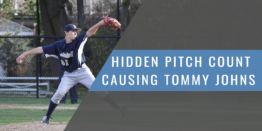| How to Deal With Common Baseball Injuries |
| By: Dr. Mark E. Pruzansky
Provided by: STACK Baseball players beat up their hands, wrists and elbows quite often, and these issues really plague their performance. As the Director of HandSport Surgery Institute I've seen and treated all kinds of sports injuries. One of the pages on our website outlines 27 baseball-related injuries and that's only a partial list. Injuries happen in predictable ways like a hard slide into a base, getting hit by a pitch or diving to make a catch. Freak accidents like falling while walking out of the clubhouse are something to contend with as well. I'll talk about some of the common hand, wrist and elbow injuries, what you can play through and what you should alert your trainer or doctor about, and what to expect if you're in the unfortunate position of needing surgery You Have .28 Seconds To Figure It Out Blink and you'll miss it. When the ball leaves the pitcher's hand at speeds that the casual fan can't comprehend, the hitter has to make a decision, "And you have .28 seconds to figure it out," former MLB outfielder Nick Swisher said in the Tim Kurkjian article for ESPN, "The horrors of getting hit by a pitch." With any injury in baseball it happens in a split second and you often don't have time to react. For many baseball injuries the only way to truly get better is to rest, but as a player you know you probably don't have time for that unless you want your season to be over. Former MLB infielder Will Rhymes explained to Kurkjian what it was like getting hit in the forearm by a pitch: "It all happened so fast," Rhymes said. "I was looking for a fastball in. He threw a slider. You have to stay in there; you have to stand your ground. As soon as he let it go, I knew it was going to hit me, [but] there was nothing I could do about it. When it hit me, I was stunned, but I thought, 'At least it didn't hit me in the head.' I thought, 'I broke my arm, but I'm glad it didn't kill me.' It was the first time I'd been hit on that bone. My arm felt dead; it went numb." Rhymes ending up passing out on the field from the pain. He didn't break his arm though and continued playing a couple of games later but, two months after the incident his arm was still tender to the touch which is what happens when ball meets bone. Broken Fingers, Thumbs and Baseball Finger Wrists
Former major leaguer Aaron Boone tells the story of breaking his hand and then his thumb in the same season: "After the game and for the next 24 hours, the pain was unbearable," he said. "They put a pin in my thumb. The next season, I got off to a really bad start because I could not grip the bat. For the first month of that season, I couldn't take a swing in the on-deck circle without pain because my thumb still hurt from September." With fractures to the fingers and thumb, the broken bone may move out of place due to the force of the injury, or the bone may just have a crack in it and stay in place. You will definitely experience pain, swelling and bruising. It will be painful and difficult to move the affected finger or thumb, and it may look crooked if the bone has moved out of place. Knowing that you're a baseball player, I'll have a pretty good idea how the injury happened but an important first step in my diagnosis is speaking with you about how it occurred and then doing the physical exam. X-rays are used to confirm the diagnosis of a bone fracture and whether the broken bone has moved out of place. I usually don't find it necessary to obtain a CT or MRI. Promptly treated, simple finger or thumb fractures that have not moved out of place or can be pushed back into place, can generally be managed by splinting, following by taping and physical therapy. Finger or thumb fractures that are unstable or significantly misaligned may require surgery to restore correct position and alignment, using very fine metal pins, screws or plates. Another common injury is Baseball Finger (or Mallet Finger), which is an injury to the thin extensor tendon that straightens the tip of the finger. With an injury, the tendon itself may tear or the force of a blow causes the tendon to pull a piece of the bone off, causing a fracture. The hallmark of the injury is sagging or drooping of the tip of the finger in a bent position and an inability to straighten it on your own. This injury is common in baseball when the ball hits the tip of the finger and jams it down. Keep in mind too that a seemingly minor sprain of the finger tip can tear the tendon, and deep lacerations (think sliding baseball cleats coming at you when you're trying to make a tag) on top of the finger can cut the tendon, resulting in the same problem. Hands and Wrists
Baltimore Orioles center fielder Adam Jones tells the story of getting hit in the wrist: "Brandon Morrow hit me with 96 on the wrist, and here it is at least a month later, and it still hurts when I do anything with it," Jones said. "But it's one of the things you have to do when you are a big leaguer. I ice it, but it doesn't help." Jones is lucky. Getting hit in the hand or wrist can lead to fractures. More commonly though scaphoid fractures in the hand and distal radius fractures in the wrist can occur from falls onto an outstretched hand. The scaphoid is one of the eight small carpal bones in your wrist joint and is on the thumb side. It looks like a twisted peanut. The scaphoid is very important for normal wrist movement, but it is also the most common carpal bone to fracture. With a scaphoid injury, sometimes the pain and swelling may not be severe and the injury may be mistaken as a wrist sprain. Scaphoid fractures that just involve a crack in the bone without movement of the fractured parts away from each other (Non-displaced) can usually be treated with just a cast immobilization. A scaphoid fracture that has moved apart (Displaced) will greatly benefit from surgery to realign the bone and insert a small screw to stabilize the fracture while it heals. The risk of non-healing is significant in scaphoid fractures due to its location - scaphoid fractures have poor blood supply and may not heal with just a cast hence the need for a minimally invasive screw fixation which leads to a shorter recovery time which is perfect for athletes. A scaphoid fracture may feel like a sprained wrist but a broken wrist will definitely look and feel like a broken wrist. Falling onto the outstretched hand is the most common way a wrist fracture happens with almost all of the force being transmitted through the Distal Radius. The Distal Radius is the end of the radius, one of the two bones in the forearm. The Distal Radius is part of the wrist joint, where it moves with the small bones of the wrist. A Distal Radius Fracture involves breaking the end of the radius within a couple of inches of the wrist joint and there are many variations to this injury depending on the force of the injury. Pain, swelling and bruising are common and something may not look right if the broken bone has moved out of place. It'll be painful to move and you'll have a hard time doing so. If you're also experiencing numbness and tingling, there may be pressure on the median nerve in the carpal tunnel which requires immediate attention to take pressure off the nerve. Simple wrist fractures can be treated with a cast in 4-6 weeks. Unstable fractures are good candidates for surgery starting with a visual examination of the joint through an arthroscope to assess the damage. Surgery may then be required which involves a metal plate and screws placed through an incision on the front of the wrist. Elbow Injuries: Funny Bone, Fractures and Pitcher's Elbow Elbow injuries are common no matter what side of the plate you're on. "I got hit in the back of the elbow by Jered Weaver," said Swisher. "My fingers were locked in a fist for five minutes." F.P. Santangelo, who had a seven-year big league career, said, "I got hit in the elbow, and for four pitches, as I was leading off first base, my hand was locked like a claw. I couldn't unclench my fist." What Swisher and Santangelo are describing are severe cases of hitting their "funny bone" that caused these temporary claw-like deformities. Hitting the funny bone is actually causing ulnar nerve dysfunction. The ulnar nerve begins from the inside of the upper arm and travels down the inside of the forearm and into the palmar and dorsal sides of the pinky and half of the ring finger. Muscles controlled by the Ulnar Nerve include the wrist and finger flexors, as well as the small muscles in the hand that coordinate fine movements. More serious are elbow fractures, which include a broad range of combinations and severity. When the outstretched arm is used to protect your face or spine, falls, diving for a catch or getting plunked in the elbow by a pitch all put the elbow at risk. Treatments can range from sling immobilization to complex reconstructive surgery of the bones and ligaments. Expect to have physical therapy if you need elbow surgery. A condition known as Pitcher's Elbow may be the batter's revenge. Pitcher's Elbow is the inflammation of the medial collateral ligament that connects the humerus to the ulna with symptoms that can include pain, clicking and elbow instability, as well as numbness in the little and ring fingers due to ulnar nerve irritation. With Pitcher's Elbow I try to treat my patients with rest, ice and anti-inflammatories. Severe cases may require arthroscopic surgery, sometimes with ligament reconstruction aka Tommy John Surgery. Young ballplayers can develop Little Leaguer's Elbow which is an adolescent condition involving the growth plate of the bone at the inner aspect of the humerus (arm bone) by the elbow. Repetitive overload stress causes inflammation and injury of this growth plate. Rest, a cooling down period of not pitching, and rehabilitation of the elbow and the entire upper extremity are needed to optimize pitching mechanics for the future. Strict adherence to pitch counts are necessary to avoid re-injury. Left untreated, Little Leaguer's Elbow can cause permanent bony deformity, pain and ulnar nerve irritation, requiring surgery.
The Fear Is Real Baseball players are intense athletes. There are some kids in little league that, when they first get hit by a pitch, decide that baseball is not for them. For the players with big league aspirations, there's a different level of dedication that not only includes playing through pain but dealing with fear. Kurkjian relays this story from former outfielder Ken Harrelson, now a broadcaster for the White Sox: "I played nine years with fear. Everyone has it. I can't remember a hundred at-bats when I didn't have fear. I almost quit my second year in the big leagues because I was so afraid. One day in Kansas City, Al Kaline, one of my idols, walked past me. He saw my fear. He said, 'We all have fear at the plate,' and kept on walking. That helped." The fear is real and so are the injuries. But you don't have to be afraid of the injuries. Sports medicine is advancing all the time and at HandSport Surgery Institute I regularly help players get back on the field. These Injuries outlined here are common because they happen all the time and you may miss part of the season but consider us orthopedic sports medicine specialists part of your team; we're here to help reach your goals. |









